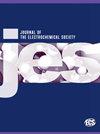Cathodic Decomposition Electrodes as Standard Reference Electrodes for Molten Salts: Example of the Lithium Eutectic Electrode for the LiCl-KCl Eutectic
IF 3.3
4区 工程技术
Q2 ELECTROCHEMISTRY
引用次数: 0
Abstract
Alternatives to the widely-used standard anodic decomposition reference electrodes in molten salts are necessary to enable more easily reproduced thermochemical and electrochemical data in molten salt electrolytes. The class of standard reference electrodes called cathodic decomposition electrodes (CDEs) are easily constructed and can be used to make thermochemical measurements in molten salts more directly compared to anodic decomposition electrodes. The lithium eutectic electrode (LEE) was chosen as a sample test case for validation and was applied to thermochemical measurements of electroactive species in molten LiCl-KCl eutectic. Transient measurements were made to measure the Li+/Li reduction potential at zero current in pure LiCl-KCl eutectic relative to a Li-alloy reference electrode to validate the reference potential of the LEE. Literature-reported electromotive force measurements against Li-alloy reference electrodes were used to generate a relationship between the LEE and the standard chlorine electrode and this relationship was used to evaluate measured and reported formal potential measurements for the LiCl-KCl-GdCl3 system. This work demonstrates the general framework for defining CDEs for any molten salt system and a method for calibrating external reference electrodes against a CDE standard reference electrode, improving the ease of obtaining thermochemical and electrochemical measurements in any molten salt system.作为熔盐标准参考电极的阴极分解电极:用于锂-氯化钾共晶的锂共晶电极示例
为了更容易地再现熔盐电解质中的热化学和电化学数据,有必要在熔盐中使用广泛使用的标准阳极分解参比电极之外,再使用其他参比电极。被称为阴极分解电极(CDE)的一类标准参比电极易于制造,与阳极分解电极相比,可以更直接地用于熔盐中的热化学测量。我们选择了锂共晶电极(LEE)作为验证样本,并将其应用于熔融锂盐-氯化钾共晶中电活性物种的热化学测量。进行了瞬态测量,测量纯 LiCl-KCl 共晶在零电流下相对于锂合金参比电极的 Li+/Li 还原电位,以验证 LEE 的参比电位。文献报道的针对锂合金参比电极的电动势测量值被用来生成 LEE 与标准氯电极之间的关系,这种关系被用来评估 LiCl-KCl-GdCl3 系统的测量值和报告的正式电势测量值。这项工作展示了为任何熔盐体系定义 CDE 的一般框架,以及根据 CDE 标准参比电极校准外部参比电极的方法,从而提高了在任何熔盐体系中获得热化学和电化学测量的便利性。
本文章由计算机程序翻译,如有差异,请以英文原文为准。
求助全文
约1分钟内获得全文
求助全文
来源期刊
CiteScore
7.20
自引率
12.80%
发文量
1369
审稿时长
1.5 months
期刊介绍:
The Journal of The Electrochemical Society (JES) is the leader in the field of solid-state and electrochemical science and technology. This peer-reviewed journal publishes an average of 450 pages of 70 articles each month. Articles are posted online, with a monthly paper edition following electronic publication. The ECS membership benefits package includes access to the electronic edition of this journal.

 求助内容:
求助内容: 应助结果提醒方式:
应助结果提醒方式:


